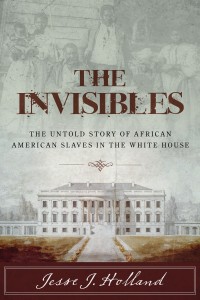By: Terri Schlichenmeyer
Book Review: The Invisibles: The Untold Story of African American Slaves in The White House
If the walls could talk, imagine what they’d say.
They’d reminisce about family meals, holidays, celebrations and romance, take sides in arguments, and watch children grow. If those walls could talk, they’d tell of triumph, disappointment, beginnings, and endings. And, as in the new book, “The Invisibles” by Jesse J. Holland, they’d talk of freedom and history.
When Barack Obama moved into the White House in 2009, he was, by far, not the first black man to live there. From the beginning, as soon as America had a president, there were slaves residing in the Executive Mansion ; in fact, says Holland , “ten of the first twelve presidents [were] slaveholders at some point in their lives.”
When George Washington fought in the Revolutionary War, his “favorite” slave, Billy Lee, went with him so it was natural that Washington would bring Lee to New York , to the first presidential mansion. Lee reportedly loved New York but when he suffered physical disabilities, Washington summarily replaced him, sending him back to Mt. Vernon where Lee was later one of a handful of slaves who comforted Washington as he died.
As a child, Oney Judge was brought up to learn sewing at Martha Washington’s knee. Years later, Washington would say that she thought of Judge as a “surrogate daughter,” but she was more than willing to give Judge away in order to keep her enslaved. Judge, by the way, was one of a few slaves known to have escaped from a president.
Thomas Jefferson brazenly took a slave to France , where slavery was disallowed; the slave, who was the brother of Jefferson ’s “concubine,” Sally, did not try to escape. When Dolley Madison fell on hard times after leaving the White House, her husband’s former slave gave her money. Andrew Jackson kept slaves in the White House stables; they were jockeys and Jackson loved racing ponies. James Monroe spoke out against slavery, even as he owned slaves. Andrew Johnson possibly had a “’colored concubine.’” And just one ex-slave of a president was “honored by a holder of that office.”
Wow.
Please practice saying that word – “Wow!” – because you’ll need it even more when you start reading “The Invisibles.”
In just under two-hundred pages, author Jesse J. Holland packs so many interesting stories, so many jaw-dropping facts that, even though there were small errors and minor repetition, I very much regretted this books’ shortness. Holland ’s storytelling skills have a way of making a reader hungry for more, and the tales he tells are surprising and even inspirational.
Some of those tales – mixed in between those of the presidents’ slaves – precede the White House, to look at slavery from the nation’s very beginning, even before there was a president. That’s where we learn that an African immigrant was the owner of the first legal slave…
Admittedly, die-hard historians might not find much new here, but I simply couldn’t put this book down. If you want something that’s short on pages but long on interest, “The Invisibles” is the one you’ll be talking about.
“The Invisibles: The Untold Story of African American Slaves in The White House” by Jesse J. Holland
c.2016, Lyons Press, $25.95 / higher in Canada, 226 pages
Comments are closed.







I’ve heard good things about this book. It sounds like it could be a bit like The Butler. I am currently reading Ice Whispers by K. Willow, book 1 in her Hidden Hills Saga. Her look at the time of slavery in the south has been a fantastic read. kwillow.com is her site for the book info as I don’t want to type the whole synopsis. But like I said, a great read!